ROSE
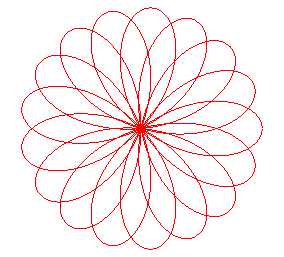
| next curve | previous curve | 2D curves | 3D curves | surfaces | fractals | polyhedra |
ROSE

| Curve studied by Guido Grandi in 1723, and by E. W. Hyde
in 1875.
Other names: rhodonea, Grandi rose, multifolium. |
| Polar equation: Algebraic curve iff n is rational; if p and q are the numerator and denominator of n, then the degree is p + q if p and q are odd, and 2(p + q) otherwise. Length of a petal: Area of a petal: |
The roses are the Brocard
transforms of a circle, when the pole is on the circle.
| They have a kinematic definition as the loci of a point
on a segment line in uniform rotation around its centre, while the point
describes the segment with a sinusoidal motion. The polar representation
of this motion is: This can be obtained in practice by tracing the small oscillations of a pendulum in uniform rotation around a vertical axis. |
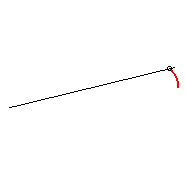 |
| The roses can also be obtained as the trajectories of
the second intersection point between a line and a circle in uniform rotation
around one of their points, or as the trajectories of the second intersection
point of two circles in uniform rotation around one of their points.
In the first case, if the speed of the circle is k
times that of the line, then the index of the rose is n = k–1,
and in the second case, if the speed of the circle is k times that
of the line, then the index of the rose is n = (k – 1) /
(k + 1).
|
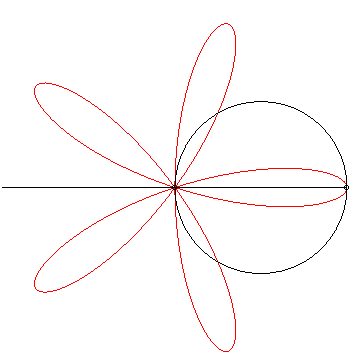 |
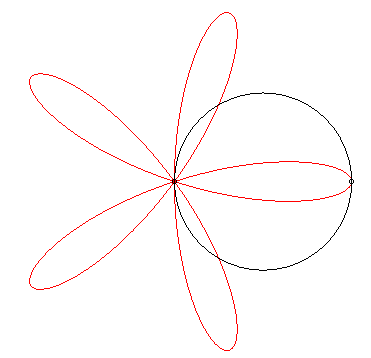 |
The roses are also the centred
trochoids passing by their centre; more precisely, such that:
- if the trochoid is defined by a
circle rolling on a circle, then the distance between the tracing point
and the centre of the moving circle is equal to the distance between the
fixed and moving circles.
- if the trochoid is defined as the
sum of two circular motions, then the radii are identical.
Even more precisely:
- for n > 1 the rose is a hypotrochoid
(base circle with radius ,
rolling circle with radius
,
distance between the point and the rolling circle =
),
and it is also the pedal of a hypocycloid
with respect to O (base circle with radius na, interior circle
with radius
na/q with
);
it can be obtained using a Spirograph.
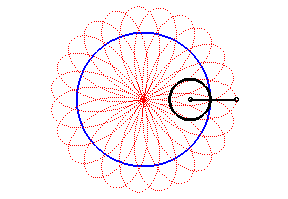
- for 0 <
< 1, it is an epitrochoid
(base circle with radius
,
rolling circle with radius
,
distance between the point and the rolling circle =
),
and it is also the pedal of an epicycloid
with respect to O (base circle with radius
,
exterior circle with radius a/pq with
).
| Application: a poi player holds a chain with the same
length as their arm, both of them turning at constant speed; when the arm
completes p>0 turns, the chain completes
q turns (we take
q >0 if the movements are in the same direction and
q
<
0 otherwise).
Then, the end of the chain describes a rose of index |

p = 1 q = -5: we get the rose of index 3/2 |
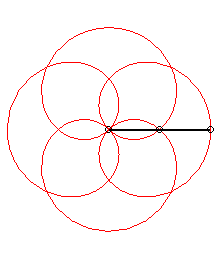 |
If the plane of the circle
is winded around a cone
with vertex O, half-angle at the vertex a,
and axis Oz, then the projection on xOy of this winded circle
is the rose:
,
which provides a construction of the roses starting from a simple circle
in the case n < 1.
|
The roses can also be obtained by projections from the cylindric sine waves, through the 3D basins. |
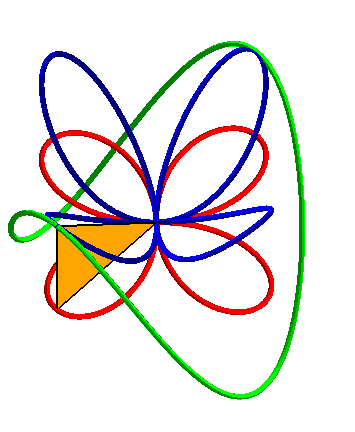 |
The curve is composed of a base pattern - the petal
or branch / leaf / lobe - symmetrical about Ox
obtained for :
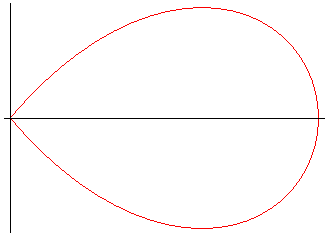
In this case, the curve is composed of 2p petals,
copies of the base petal by rotations by
and
+
p.
When p and q are odd, the curve is composed
of p petals, copies of the base petal by rotations by .
Examples:

n = 1: circle |

n = 2 :quatrefoil (or quadrifolium) |

n = 3: regular trifolium |

n = 4 |

n = 5 |

n = 1/2: Dürer folium |

n = 3/2 |

n = 5/2 |

n = 7/2 |

n = 9/2 |

n = 1/3: trisectrix limaçon |

n = 2/3 |

n = 4/3 |

n = 5/3 |

n = 7/3 |

n = 1/4 |

n = 3/4 |

n = 5/4 |

n = 7/4 |

n = 9/4 |

n = 1/5 |

n = 2/5 |

n = 3/5 |

n = 4/5 |

n = 6/5 |
When n is irrational, the rose is dense in the disk D(O, a).
The roses are views from above of the clelias.
They also are the inverses of the epispirals and the pedals of the centred cycloids.
Compare them to the sinusoidal spirals.
See also conchoid of a rose and radial curve as well as secantoidal .
See also the rhombic roses.

| next curve | previous curve | 2D curves | 3D curves | surfaces | fractals | polyhedra |
© Robert FERRÉOL 2017